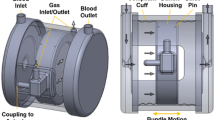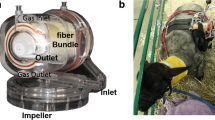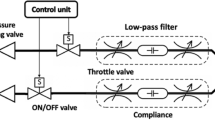Abstract
The purpose of this study was to investigate the effect of multiple mechanical forces in gas exchange and hemolysis in an intravascular lung assist device (IVLAD). Specific focus was given to the effect of membrane vibration. We designed the oscillatory type artificial lung assist device attached with a polyvinylidene fluoride sensor and a lead zirconate titanate (PZT) actuator (vibrator). Maximum oxygen transfer occurred at a frequency of 7 Hz for bovine blood and 35 Hz for distilled water. The normalized index of hemolysis oxygenator values for the circuit was 0.0014 g/mL for excitation of the PZT actuator with a sinusoidal 10-V wave and 0.0018 g/mL for a 50-V wave. The experiment results indicate effective performance in enhancing the gas transfer of the IVLAD. This novel hollow membrane filter IVLAD design demonstrates an acceptable level of gas exchange performance with an acceptable level of blood compatibility, and so it has potential as an implantable lung assist device for patients with acute respiratory distress syndrome.
Similar content being viewed by others
References
Fazzalari, F. L., Bartlett, R. H., Bonnel, M. R. and Montoya, J. P., “An Intrapleural Lung Prosthesis: Rationale, Design and Testing,” Artifi. Organs, Vol. 18, Issue 11, pp. 801–805, 1994.
Mortensen, J. D., “Intravascular oxygenator: A new alternative method for augmenting blood gas transfer in patient with acute respiratory failure,” Artif. Organs, Vol. 16, Issue 1, pp. 75–82, 1992.
Vaslef, S. N., Mockros, L. F., Anderson, R. W. and Leonard, R. J., “Use of a mathematical model to predict oxygen transfer rates in hollow fiber membrane oxygenators,” ASAIO J., Vol. 40, No. 4, pp. 990–996, 1994.
Keraita, J. N. and Kim, K. H., “A Weighing Algorithm for Multihead Weighers,” International Journal of Precision Engineering and Manufacturing, Vol. 8, No. 1, pp. 21–26, 2007.
Weissman, H. M. and Mockros, L. F., “Gas transfer to blood flowing in coiled circular tubes,” J. Eng. Mech. Div. ASCM., Vol. 94, pp. 857–872, 1968.
Tanishita, K., Richardson, P. D. and Galletti, P. M., “Tightly wound coils of microporous tubing: progress with secondary flow blood oxygenator design,” Trans. Amer. Soc. Artif. Int. Organs, Vol. 21, No. 4, pp. 216–222, 1975.
Streeter, V. L., Wylie, E. B. and Bedford, K., “Fluid Mechanics (9th ed.),” McGrew-Hill Inc., 1998.
Kim, G. B., Kim, S. J., Hong, C. U., Kwon, T. K. and Kim, N. G., “Enhancement of oxygen transfer in hollow fiber membrane by the vibration method,” Korean J. Chem. Eng., Vol. 22, No. 4, pp. 521–527, 2005.
Kim, G. B., Hong, C. U. and Kwon, T. K., “Vibration characterictics of PZT Actuator by fluid flow in intravascular oxygenator,” Jpn. J. Appl. Phys., Vol. 45, No. 4B, pp. 3811–3817, 2006.
Hattler, B. G., Reeder, G. D., Sawzik, P. J., Lund, L. W., Walters, F. R., Shah, A. S., Rawleigh, J., Goode, J. S., Klain, M. and Borovetz, H., “Development of an intravenous membrane oxygenator: Enhanced intravenous gas exchange through convective mixing of blood around hollow fiber membranes,” Artif. Organs, Vol. 18, No. 11, pp. 806–812, 1994.
Nosè, Y. “Recommended Practice for Assessment of Hemolysis in Continous Flow Blood Pump. West Conshohoken, PA,” American Society of Testing and Materials, F04, pp. 40–41, 1998.
Naito, K., Mizuguchi, K. and Nosè, Y., “The Need for Standardizing the Index of Hemolysis,” Artifi. Organs, Vol. 18, No. 1, pp. 7–10, 1994.
ISO/CD 199.2. Blood-gas Exchangers (Oxygenators) Document ISO/TC 150/SC2/WG/ N 103, 1993.
AAMI Standard: Cardionascular/Neurology Standards for Blood/Gas Exchanger Devices (Oxygenators); 1998.
Ishige, M., Matsuura, F., Kawasugi, M. and Aketagawa, M., “Phase Modulation Homodyne Interferometer with a 10-pm Resolution Using a Tunable Laser Diode,” International Journal of Precision Engineering and Manufacturing, Vol. 8, No. 2, pp. 80–84, 2007.
Kim, G. B., Kwon, T. K., Lee, S. C., Kim, S. J., Cheong, I. S., Oh, I. H., Kim, K. J., Byun, Y. S. and Jheong, G. R., “Characteristics of Oxygen Transfer in Intravascular Lung Assist Device by Vibrating,” Korean J. Chem. Eng. Res., Vol. 42, No. 2, pp. 151–162, 2004.
Annual Book of ASTM Standards: Section 13 Medical Devices and Services, F1841-97, 1998.
Author information
Authors and Affiliations
Corresponding author
Rights and permissions
About this article
Cite this article
Hong, CU., Kim, JM., Kim, MH. et al. Gas transfer and hemolysis in an intravascular lung assist device using a PZT actuator. Int. J. Precis. Eng. Manuf. 10, 67–73 (2009). https://doi.org/10.1007/s12541-009-0010-7
Received:
Accepted:
Published:
Issue Date:
DOI: https://doi.org/10.1007/s12541-009-0010-7




